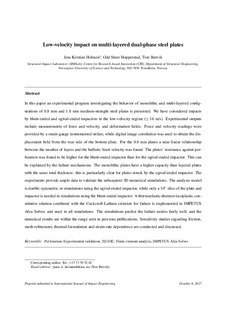| dc.contributor.author | Holmen, Jens Kristian | |
| dc.contributor.author | Hopperstad, Odd Sture | |
| dc.contributor.author | Børvik, Tore | |
| dc.date.accessioned | 2017-10-17T07:34:29Z | |
| dc.date.available | 2017-10-17T07:34:29Z | |
| dc.date.created | 2015-06-12T10:25:18Z | |
| dc.date.issued | 2015 | |
| dc.identifier.citation | International Journal of Impact Engineering. 2015, 78 161-177. | nb_NO |
| dc.identifier.issn | 0734-743X | |
| dc.identifier.uri | http://hdl.handle.net/11250/2460481 | |
| dc.description.abstract | In this paper an experimental program investigating the behavior of monolithic and multi-layered configurations of 0.8 mm and 1.8 mm medium-strength steel plates is presented. We have considered impacts by blunt-ended and ogival-ended impactors in the low-velocity regime (≤16 m/s). Experimental outputs include measurements of force and velocity, and deformation fields. Force and velocity readings were provided by a strain-gauge instrumented striker, while digital image correlation was used to obtain the displacement field from the rear side of the bottom plate. For the 0.8 mm plates a near linear relationship between the number of layers and the ballistic limit velocity was found. The plates' resistance against perforation was found to be higher for the blunt-ended impactor than for the ogival-ended impactor. This can be explained by the failure mechanisms. The monolithic plates have a higher capacity than layered plates with the same total thickness: this is particularly clear for plates struck by the ogival-ended impactor. The experiments provide ample data to validate the subsequent 3D numerical simulations. The analysis model is double-symmetric in simulations using the ogival-ended impactor, while only a 10° slice of the plate and impactor is needed in simulations using the blunt-ended impactor. A thermoelastic–thermoviscoplastic constitutive relation combined with the Cockcroft-Latham criterion for failure is implemented in IMPETUS Afea Solver, and used in all simulations. The simulations predict the failure modes fairly well, and the numerical results are within the range seen in previous publications. Sensitivity studies regarding friction, mesh refinement, thermal formulation and strain-rate dependence are conducted and discussed. | nb_NO |
| dc.language.iso | eng | nb_NO |
| dc.publisher | Elsevier | nb_NO |
| dc.rights | Attribution-NonCommercial-NoDerivatives 4.0 Internasjonal | * |
| dc.rights.uri | http://creativecommons.org/licenses/by-nc-nd/4.0/deed.no | * |
| dc.title | Low-velocity impact on multi-layered dual-phase steel plates | nb_NO |
| dc.type | Journal article | nb_NO |
| dc.type | Peer reviewed | nb_NO |
| dc.description.version | acceptedVersion | nb_NO |
| dc.source.pagenumber | 161-177 | nb_NO |
| dc.source.volume | 78 | nb_NO |
| dc.source.journal | International Journal of Impact Engineering | nb_NO |
| dc.identifier.doi | 10.1016/j.ijimpeng.2014.12.005 | |
| dc.identifier.cristin | 1247778 | |
| dc.relation.project | Norges forskningsråd: 237885 | nb_NO |
| dc.description.localcode | © 2015. This is the authors’ accepted and refereed manuscript to the article. This manuscript version is made available under the CC-BY-NC-ND 4.0 license http://creativecommons.org/licenses/by-nc-nd/4.0/ | nb_NO |
| cristin.unitcode | 194,64,45,0 | |
| cristin.unitname | Institutt for konstruksjonsteknikk | |
| cristin.ispublished | true | |
| cristin.fulltext | original | |
| cristin.fulltext | postprint | |
| cristin.qualitycode | 1 | |

